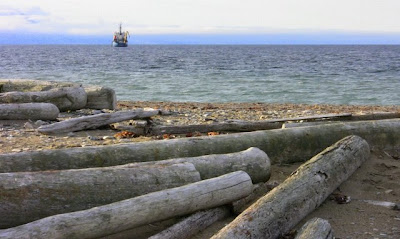*
HISTORY OF THE GREENLAND QAJAQ
Thursday, February 14, 2019
Thursday, July 22, 2010
A friend's daughter's kayak
Wednesday, October 15, 2008

Glaciers in Siberia carry downed trees...

from the boreal forests...

down to the rivers...

and out to sea.

In the massive transpolar currents and the Beaufort gyre the trees will spend 2-20 years adrift, getting cleaned and whittled down in size by the presence of constant ice which stretches down to the 80th parallel until early summer when it begins to break up...

until they end up on a remote beach in Greenland...



You'll notice how small and sleek these Greenland kayaks are. As opposed to the larger Alleutian kayaks of Northern Canada and Alaska these were intended for fairly short hunting trips. Most Greenlanders in many cases, spent the day hunting, going virtually just around the corner to find seal. Of course that 'corner' might be a point several miles away. And only certain times of year, when the ice was nearby, not in summer when it had moved further North. Seals are found only in the ice so these boats had to withstand these harsh conditions.

down to the rivers...

and out to sea.

In the massive transpolar currents and the Beaufort gyre the trees will spend 2-20 years adrift, getting cleaned and whittled down in size by the presence of constant ice which stretches down to the 80th parallel until early summer when it begins to break up...

until they end up on a remote beach in Greenland...
where a seal hunter will choose just the right one...



You'll notice how small and sleek these Greenland kayaks are. As opposed to the larger Alleutian kayaks of Northern Canada and Alaska these were intended for fairly short hunting trips. Most Greenlanders in many cases, spent the day hunting, going virtually just around the corner to find seal. Of course that 'corner' might be a point several miles away. And only certain times of year, when the ice was nearby, not in summer when it had moved further North. Seals are found only in the ice so these boats had to withstand these harsh conditions.

These photos are of an old frame on display in the two-room museum I visited in Ittoqortormitt, East Greenland. Summer 2008

A modern day re-creation, below.


Looking aft, below...notice the deck is nearly flat, making rolling easier. Inuit boats such as these were designed to roll.
I have no trouble rolling one of these. But transferring it to my Swede design medium chine hulled boat hasn't worked for me yet.

Looking forward:
Flaying the seal skin.
This woman's wearing traditional seal skin boots for everyday use. Women generally skinned the seal, treated it then stitched the outer covering of the qayaqs while men built the frames. Women did not paddle kayaks.
This woman's wearing traditional seal skin boots for everyday use. Women generally skinned the seal, treated it then stitched the outer covering of the qayaqs while men built the frames. Women did not paddle kayaks.


The seal skin on display at the Ittoqortormitt Museum. This woman talked about her father, husband and brothers hunting seal in their boats. She was proud to show me this skin and describe how she and the other women cured them and prepared them for use making the qayaqs.
The seal skin is attached while still wet from the curing brine and left to dry once stitched into place.




Next are Greenland style paddles with bone edges and tips to strengthen the wood against the ice. Each paddle is custom made for the owner. The length of the paddle is as high as the person can reach with the fingers curled over, the loom (shaft) is the size of the opening created when middle finger tip touches thumb tip, the blade width is the size of the person's hand creating a wide "C" with the curved fingers stretched, and the length of the loom is the width of the person's hands as they clear the hips.
Practicing rolling...

Children are introduced early on to kayak making and training their boat handling skills. One must be able to roll a kayak before setting out seal hunting. If you cannot roll you will die. The boat is so difficult to reenter in the water that a wet exit is not an option.

Practicing bracing, balancing and rolling with the help of older, more experienced seal hunters. As soon as the kayaker capsizes he grabs the paddle supported by the other two kayaks to get the feel of bringing the boat back upright.

This might be a proud school group showing their combined effort, perhaps a school project.
A fine example of deck rigging to hold the numerous and various hunting tools. The fittings are made of bone while the rope is made of sinew or tightly wrapped seal skin. Note the bone edge on the paddle blade, intended to strengthen the edge against the ice. The deck riggings were iron clad. Anything attached would be held in position even during the roughest conditions, and were necessary for holding hunting tools.
The screen allowed a stealthy hunter to disguise himself as a floating bit of ice.
A proud hunter displaying a fine array of handmade hunting tools.

Another very proud hunter, an obviously skilled craftsman, eagerly looking to sea anticipating the hunt. Note the round device on the foredeck, intended to support the rope so it can play out without hinderance. It's made of a bit of bent wood, has a suspended net and is supported by three legs. The gap below and in front allows space for the smaller hunting tools. Even his storage rack is a well thought out and executed design.
Subscribe to:
Posts (Atom)


























